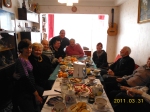 KIEV, UKRAINE, April 1, 3 p.m. – The walls are talking at the Kiev ORT Technology Lyceum – and they’re trilingual.
KIEV, UKRAINE, April 1, 3 p.m. – The walls are talking at the Kiev ORT Technology Lyceum – and they’re trilingual.
There’s the list of scholastic achievements of students on the bulletin board near the main lobby, made possible through curriculum provided by the Ukrainian Ministry of Education. Nearby are the photos of students celebrating Jewish holidays and customs, courtesy of Hebrew and cultural programs from the Israeli Ministry of Education. And then there’s that shiny certificate in English from Microsoft, a result of World ORT’s efforts to put the school on the cutting edge of technology education.
The ORT Kiev Technology Lyceum, which has 258 students, grades 5 through 12, has become the only school in Ukraine to be chosen by Microsoft to join its small, exclusive international group of innovative Pathfinder Schools.
 It was one of 56 schools selected recently from 114 applicants in 48 countries to join the Microsoft Partners in Learning Innovative Schools Program, a ten-year, $500 million commitment by the company to help schools and teachers use technology to advance teaching and learning more effectively, according to an announcement on the World ORT web site.
It was one of 56 schools selected recently from 114 applicants in 48 countries to join the Microsoft Partners in Learning Innovative Schools Program, a ten-year, $500 million commitment by the company to help schools and teachers use technology to advance teaching and learning more effectively, according to an announcement on the World ORT web site.
“The fact that this Lyceum is the only school in Ukraine chosen for this role is further recognition of ORT’s leading position in education in that country,” Shelley B. Fagel, National President of ORT America, stated in the press release.
She said American donors are committed to implementing innovative technologies and modern educational practices at ORT schools throughout the CIS and Baltic States. “This is yet another prime example of how our donors’ dollars are helping to foster excellence, no matter how great the challenges.”
 Despite ongoing funding challenges – which have resulted in teachers being poorly paid, the end to free hot lunches and school bus service – the ORT Kiev Technology Lyceum has consistently managed to raise its educational standards, increase student enrollment and retain skilled staff despite the lure of higher pay at the city’s other private schools, the announcement noted.
Despite ongoing funding challenges – which have resulted in teachers being poorly paid, the end to free hot lunches and school bus service – the ORT Kiev Technology Lyceum has consistently managed to raise its educational standards, increase student enrollment and retain skilled staff despite the lure of higher pay at the city’s other private schools, the announcement noted.
Microsoft’s acceptance letter states: “The ORT Kiev Technology Lyceum has demonstrated strong school leadership with a proven record of innovation and successful change implementation, and a vision for learning that has already started the school on the road to reform and improvement.”
ORT Programs at Jewish schools in Ukraine are carried out as the joint projects with the Israeli Government, the Jewish Agency and the local education authorities. The relationship between ORT and the Ukrainian Ministry of Education has resulted in the adoption of ORT teaching strategies at several state schools, especially in the area of technological subjects.
 Tenth-graders Denis, Sasha, Melissa and Alina are shining examples of the successful trifecta of general education, Jewish learning and technology. Alina, in fact, is fluent in English, Ukrainian and Hebrew. Sasha and Melissa are already leaning toward technology for their careers while Denis wants to be a translator - he recently won the first stage of the local Computer Olympics.
Tenth-graders Denis, Sasha, Melissa and Alina are shining examples of the successful trifecta of general education, Jewish learning and technology. Alina, in fact, is fluent in English, Ukrainian and Hebrew. Sasha and Melissa are already leaning toward technology for their careers while Denis wants to be a translator - he recently won the first stage of the local Computer Olympics.
All are aware of their Jewish roots and the holidays and customs that define them as Jews. In Sasha’s case, “I tell my parents about these traditions.”
Many of the school’s students will eventually travel to Israel on programs like Limud, MASA and NALA. Some will go to Israel for good. But wherever these “pathfinders” land, they will have a well-rounded education – along with a few languages – to help them be successful wherever they are.



 Posted by israelmission
Posted by israelmission 



